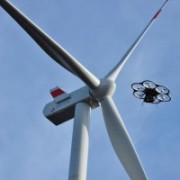Dedrone at US Presidential debate
New Technology to Guard Against Drone Misuse During Final Presidential Debate
Las Vegas/San Francisco – October 20, 2016 – The Las Vegas Metropolitan Police Department (LVMPD) used a sophisticated system of automated sensors and networked software to detect and identify potential drone threats during the final presidential debate between Hillary Clinton and Donald Trump, held yesterday at the Thomas & Mack Center, University of Nevada, Las Vegas (UNLV).
In the wrong hands, ‘off-the-shelve’ drones represent a serious security threat at public events. The White House is raising concerns about readily available drones that can carry weapons or explosives on pre-programmed flights paths, or be flown by concealed operators. Militant terrorist organizations have already used such drones in fatal attacks overseas.
“Having technology that will protect us from the air was a huge advantage to having a safe and uneventful evening”
For the Las Vegas presidential debate, the LVMPD integrated a complete drone detection and counter-drone solution from Dedrone with its own security measures. “Even though Las Vegas has hosted heads of state and presidents, the presidential debate coupled with the large crowd that it drew, posed a unique set of risks,” LVMPD Assistant Sheriff Tom Roberts said. “We were able to seamlessly integrate the tracker into our safety plan. Having technology that will protect us from the air and provide real-time information was a huge advantage to having a safe and uneventful evening.”
“All drone sightings were reported to the LVMPD in real time”
Automated monitoring of the airspace above the university was provided by Dedrone and its partner AirVu, a global leader in unmanned aerial security. Together they deployed a network of multi-sensor DroneTrackers to detect and identify drone incursions in a radius of several hundred meters from the debate location, extending beyond the campus perimeter. The DroneTracker system recognized approaching drones using arrays of visual, acoustic and radio frequency sensors, and reported results to the LVMPD’s operations security center.
All drone sightings were reported to the LVMPD in real time, with critical incident information such a drone type, video footage, position and flight path available via command to other security agencies, including the FBI and the Secret Service.
“Airspace security is now as vital as security on the ground”
“Protecting the public from malicious drones is increasingly on the agenda of today’s security agencies,” said Dedrone CEO Jörg Lamprecht. “Millions of drones are sold each year. Cheaper drones are easily purchased by enthusiasts and photographers, but the technology has been used by militant groups as well. Airspace security is now as vital as security on the ground. We are very proud that our technology was selected to protect such a high-level national event, and that we were able to contribute to a successful outcome.”
Background information
• Restriction bars drones from flying around UNLV during debate
• Iraq attack shows deadly potential of ‘off-the-shelf’ drones
• Drone Incidents
Videos
• DroneTracker in action
• What drones are capable of
About Dedrone
Dedrone is the international market and technology leader in drone detection. Its automated, software-based aerial intrusion detection platform DroneTracker provides early warning of illegal civilian UAVs and is used to protect data centers, government buildings, stadiums, prisons and other critical infrastructure installations against smugglers, spies and terrorist attacks. Depending on requirements, various countermeasures, such as jammers, can be integrated and be triggered automatically. DroneTracker is currently distributed by more than 150 partners in 50 countries. Dedrone, founded in 2014, is based in San Francisco, CA (USA) and is backed by US and international investors. Research and development are based in Kassel, Germany.
Original post:
http://www.dedrone.com/en/newsroom/press-detail/automated-drone-detection-system-helps-secure-final-presidential-debate






